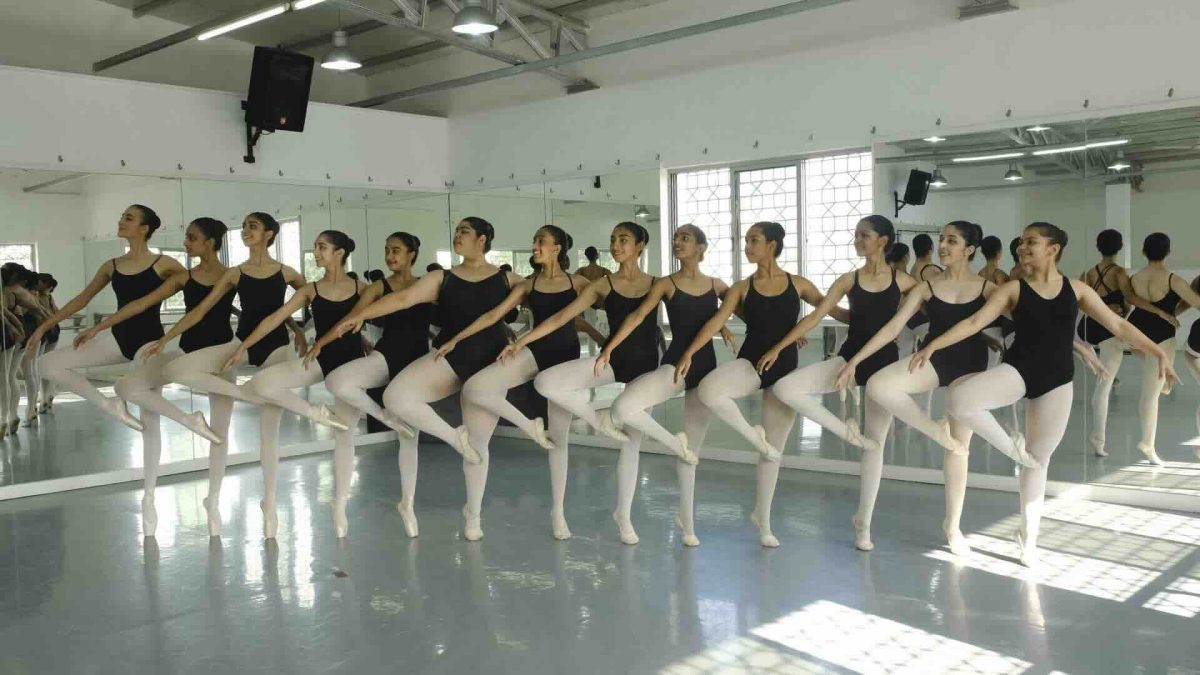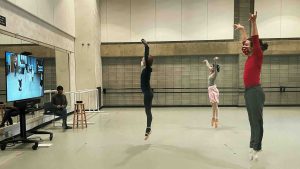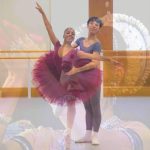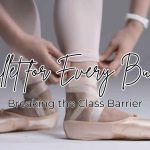Article by: Shayna Sunu
Cover image: A shot during rehearsals for Recital 2023, a show by TLFCB post the pandemic.
Classical Ballet is an art form that demands extensive training, irrespective of a dancer’s age or expertise. Everything from establishing the right alignment, developing the rhythm, learning the positions to instilling patience and discipline requires structured instruction and rigorous practice.
With the growing advancements in technology and its integration into various fields, where everything is becoming digital, the question arises: Why isn’t ballet taught or learnt online? Are virtual ballet classes inherently less effective than in-person training? Well, the answer isn’t as simple as a ‘yes’ or ‘no.’
A Teacher’s Perspective on Online Ballet
The 2020 COVID pandemic pushed nearly all organizations and dance instructors to shift their training and instruction to a completely online platform- suddenly and without preparation. Ms. Yana Lewis, the artistic director and teacher at TLFCB, underwent a very similar experience during two years of lockdown. Shifting from a studio full of students to a big screen full of multiple windows certainly hadn’t been an easy switch. “I felt like a T.V. presenter,” she said with a laugh, summarizing her experience. Delving a little deeper, she talked about how ballet was not just about movements and positions anymore; the use of play and props became essential. Teaching tools like toys, puppets and figurines had to be integrated to hold the attention of the 4-year-olds. Asking children to bring a prop they could find at home or dress up as a character sparked creativity and opened up new ways for them to express themselves through movement. This not only enhanced visual learning but also helped maintain focus and engagement, especially in a virtual environment where distractions were more frequent (Cpybadmin & Cpybadmin, 2023). However, managing multiple screens and dealing with frozen videos and unclear audio, all while keeping the class engaged became a different challenge of its own.
Along similar lines, Ms. Elina Wisung, ballet teacher at TLFCB, shared that the experience had been “frustrating” due to the complete switch to an online platform. There was a certain sense of “monotony,” as everything was confined within four walls. Ballet requires physical corrections, and the lack of a physical and personal connection with the students took away an essential part of the experience. Did kids keep coming back? Yes. Did the kids progress? Yes. Did they fall in love with Ballet? Absolutely.
So, then, what about it didn’t make it a long-term solution? Yana talked about how it is “doable, but also challenging” and, most importantly, it wasn’t the “right way to teach a performing art.” Ballet is an art form that thrives on physical presence, hands-on corrections, and the energy of a shared space, elements that simply cannot be fully replicated through a screen.
Limitations of online ballet teaching
While online platforms provide a promising avenue to increase the accessibility of services, including performing arts, the restrictions they pose are also on the higher side, which requires due consideration and thought before commencing any type of training, especially a performing art like ballet. Technical issues such as poor internet connectivity, software incompatibility, and unexpected glitches can disrupt classes, leading to frustration and confusion about the content being taught. Additionally, feedback and instruction can be compromised, as teachers may struggle to provide real-time corrections or accurately assess techniques without in-person observation (Kang et al., 2023). This lack of immediate interaction makes it difficult for students to ask questions and refine their movements effectively. Student engagement and motivation also pose concerns; without in-person companionship, students may feel isolated, leading to reduced participation and a weaker sense of community (Yu & Liu, 2023).
Should online ballet training be dismissed entirely?
Dr. Dara Milovanovic, an Associate Professor of Dance at the University of Nicosia, Greece, proposes that online ballet classes have fostered a more democratic and participatory approach to dance education. Her research highlights how virtual platforms expand global engagement with ballet, making it accessible to dancers in geographically remote areas.
Major benefits of online ballet training include increased accessibility, flexibility and convenience, affordability, diverse learning approaches, technological tools like video playback aid in self-correction and improvement and an increased exposure to different ballet styles (Milovanovic, 2021).
Focusing specifically on the point of accessibility, Milovanovic states that for beginners, online platforms could be an excellent introduction to ballet fundamentals before committing to in-person training. For advanced dancers, offering masterclasses, injury prevention lessons, and professional development opportunities would enhance their experiences and growth as ballet dancers. Yet, opinions on these vary depending on the instructor’s pedagogy and compatibility with technology.
Learning the fundamentals of ballet is one of the most crucial steps in a dancer’s journey. However, online training often does not do justice to this process. Students may unknowingly learn techniques incorrectly or fail to give enough attention to the foundational elements. Over time, their bodies adapt to these patterns, making it much harder to unlearn and relearn the correct technique later on.
While challenges exist, online ballet training offers an inclusive alternative, breaking traditional barriers to dance education. Having said that, transitioning ballet training entirely to an online format does not preserve the integrity of the art form. Hence, it makes sense to integrate online training formats as an aid to in-person instruction rather than a complete replacement.
Blended Learning: A New Approach to Teach Ballet
Blended learning, a relatively new concept that has gained traction with the rise of computers and the internet is an emerging phenomenon. Also known as hybrid learning, this approach combines online educational resources and interactive digital opportunities with traditional in-person instruction. When we talk about online educational materials, specifically in ballet, these classes don’t necessarily have to be full-fledged. Instead, they could include tutorials on perfecting techniques, blogs on the must-haves for a dancer, and addressing common struggles or insights into the history of ballet. These resources don’t just enhance a dancer’s technical skills but also deepen their understanding and appreciation of the art form they practice.
A research study done on a group of beginner ballet dancers at the University of Jordan compares the effect of Blended Learning and face-to-face teaching, which revealed no significant differences in performance levels between the two teaching strategies (Bayyat, 2019). However, the blended learning approach significantly enhanced students’ motivation in ballet training. It increased intrinsic motivation, fostering a stronger desire to learn, greater satisfaction in mastering techniques, and more enjoyment in the process. Extrinsic motivation also increased as students benefited from flexible learning and additional resources. Overall, blended learning students showed higher engagement and higher motivation compared to those in traditional face-to-face classes, making them more invested in their learning experience.
While some organizations offer online ballet training, it is usually either fully online or entirely in-person, rarely a combination of both. This means dancers often experience only the advantages and limitations of one format, which can lead to frustration or accessibility challenges, depending on the format they choose to go for.
TLFCB provides ‘Stretch and Beyond for Ballet,’ a class that uses the blended format of instruction, tailored for students of ballet to improve their classical technique through stretching and strengthening exercises. This ensures that the students pay attention to improving their flexibility, strength and placements, which will further aid in their regular ballet classes. The hybrid mode makes it more accessible to students who may not be able to travel long distances.
Blended learning brings together the best of both online and in-person formats, enhancing motivation and engagement, making it a promising model for the future of ballet education. However, implementing this approach effectively would require thoughtful planning and structure. Institutions need to assess which aspects of the syllabus are suitable for online instruction, whether such methods truly benefit students, and what might prove counterproductive. Most importantly, it’s essential to consider whether ballet teachers find the online medium effective and sustainable. With technology evolving rapidly and online learning becoming increasingly mainstream, blended learning for ballet is certainly a feasible option, but striking the right balance is essential.
TLFCB & other digital initiatives
A quick glance through social media platforms like Instagram offers a broad overview of the diverse dance resources available, from technique breakdowns to explanations of how and where these techniques can be applied in choreography. At TLFCB, for instance, ‘Technique Tuesdays’ feature instructors offering quick run-throughs of ballet techniques and tips on how to master them. There’s also a monthly newsletter that not only gives you glimpses of students and their achievements but also provides you with ballet content that you can further engage with. Additionally, blogs on topics like making tutus, tiaras, and applying makeup not only make the learning process more interactive for students and parents but also equip dancers with a range of complementary skills beyond just movement.
There are other online pages and artists that offer ballet training and resources. ‘Ballet with Isabella’ provides an extensive library of online ballet classes and courses for all levels. ‘Athletistry’ offers a comprehensive app designed to serve as a ballet and strength coach that features a variety of training options, including structured strength programs and quick ballet technique sessions adaptable to different skill levels and goals. ‘Runqiao Du Ballet Coaching’ by Runqiao Dao, a seasoned ballet professional, provides live online coaching, in-person intensives, and teachers’ training programs, aiming to make high-quality ballet training accessible to all enthusiasts. The list does not end here and one can find various other ballet resources and guides on the internet that can enhance one in the journey of learning ballet.
Several platforms also offer high-quality online ballet masterclasses, making expert training accessible worldwide. Dancio features classes by renowned dancers like Irina Dvorovenko, catering to all levels. The Royal Ballet School’s “Ballet on Demand” and the Online Ballet Academy offer structured programs with step-by-step tutorials. Russian Masters Ballet hosts Zoom-based masterclasses for young dancers, while the English National Ballet provides beginner-friendly sessions through BalletActive. These platforms blend professional guidance with flexible learning, making them valuable for students and teachers alike.
Now, returning to the initial question of whether practicing ballet through virtual platforms is less effective than in-person training, the answer isn’t a yes or no. Its effectiveness depends on several factors, such as the age group of students, the teaching methods adopted, and the level of comfort with technology. However, relying solely on online resources may not be the most well-rounded approach. As shared by our instructors, ballet is a performing art that thrives on physical presence and connection, something that is difficult to replicate through a screen. That said, when used as a supplementary tool, technology can significantly enrich a dancer’s learning, expanding both skill sets and knowledge in meaningful ways.









Leave a Reply